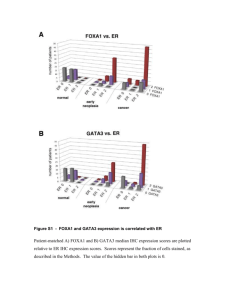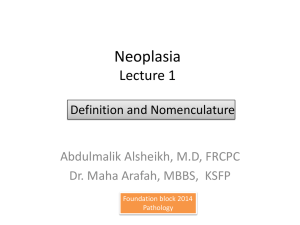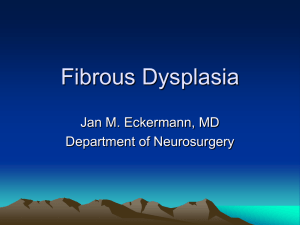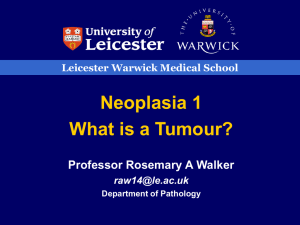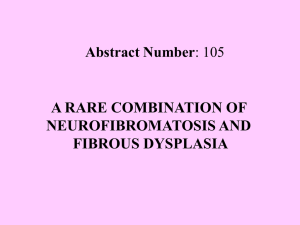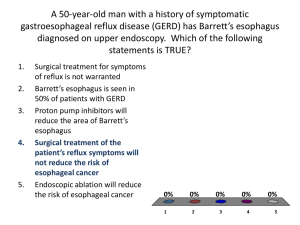Neoplasia new Lectures 2012 - Fahd Al
advertisement
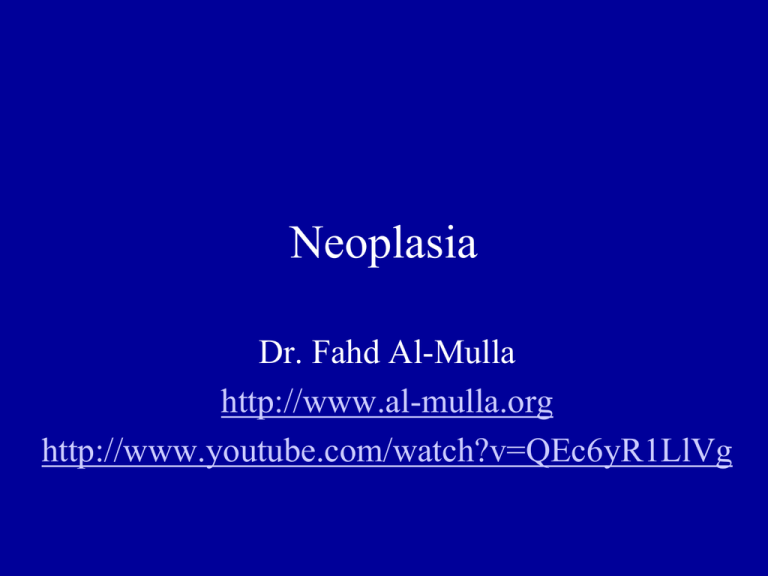
Neoplasia Dr. Fahd Al-Mulla http://www.al-mulla.org http://www.youtube.com/watch?v=QEc6yR1LlVg Neoplasia •Neoplasia I • Definition • Metaplasia, anaplasia, dysplasia, Ca in Situ, Benign vs. invasive carcinoma. • Classification and nomenclature • Histological features •Neoplasia II • Tumour grading and staging • Mechanisms and Types of cancer spread • Effects of tumours on host: local effects, cancer cachexia, paraneoplastic syndromes. •Carcinogenesis • Etiology (causes) of neoplasia. • Environmental carcinogens and process of carcinogenesis • Molecular Basis of Neoplasia Neoplasia Neoplasia is defined as: " an abnormal mass of tissue, resembling the tissue of origin, the growth of which exceeds and is uncoordinated with that of the normal tissues and persists in the same excessive manner after cessation of the stimuli that evoked the change." Neoplasia has genetic and environmental causes. It is important to note that both play parts in causing neoplasia. Neoplasia • Tumor • Irreversible • Morphological resemblance to tissue of origin • Functional resemblance to tissue of origin • Autonomy • Harmful Metaplasia Definition Conversion of one type of differentiated tissue into another type of differentiated tissue. It is a form of adaptation. It is benign and reversible. Stimulant causing metaplasia may persist and play a role in carcinogenesis. e.g. Squamous metaplasia of bronchial respiratory epithelium in smokers. e.g Columnar epithelium of endocervix replaced by Squamous epithelium in chronic inflammation of Cervix. What is Hyperplasia? Dysplasia? Anaplasia? Benign neoplasia Definition Uncontrolled focal proliferation/growth of welldifferentiated cells. Cells resembling the tissue of origin. Does not invade or metastasise (mobile/smooth edges) Encapsulated (fibrous capsule) May show dysplasia Adenoma of colon Leiomyoma (fibroid) of the uterus Menigioma Endocrine tumors – produce hormones Remember that something which is benign by the pathologist may have significant clinical effects on the patient: • Space occupying lesion (Brain/spinal cord) • Secret Hormones (Pancreatic insulinoma, parathyroid) • Some types colonic adenomas may later become anaplastic . Should be considered pre-cancerous. Parathyroid adenoma Gallbladder Dysplasia Anaplasia • Nuclear/cytoplasmic ratio • Hyperchromatism • Mitosis/abnormal • Pleomorphism • Necrosis • Angiogenesis In situ cancer or cancer In-situ carcinoma An alteration in architecture and cytological appearance Which is similar to that seen in malignant tumour that does not show any invasion. Dysplasia Definition Combination of abnormal cytological feature and abnormal tissue architecture. It has pre-cancerous association. e.g dysplasia in the cervical epithelium. Increase cell size. - hyperchromatism - loss of orientation of the cells - haphazardly and abnormally sited mitotic activity - loss of maturation - nuclear pleomorphism Same as cancer features but differ in extent. When full thickness involved – carcinoma in-situ – severe dysplasia lower third mild dysplasia two third moderate dysplasia e.g. CIN & VIN Anaplasia Anaplasia N.B. Normal Dysplasia Anaplasia Invasion Don’t assume that dysplasia is irreversible. Mild dysplasia may revert to normal if stimulus removed (managed less agressively but followed up). Severe dysplasia often progress to cancer if left untreated (treated as a favourable type of cancer). The Concept of dysplasia as a Cancer in its early stages has led to institution of screening programmes for cervical and breast cancer. Invasion and Metastasis WHOLE MARK OF CANCER Astrological cancer sign © Classification of tumors Epithelium Benign: Papillomas, adenomas, polyps Malignant: Carcinomas (Adenocarcinomas, glands) Non-epithelial tissues: connective tissue -Sarcoma lymphoid tissue-Lymphoma mesenchymal/mesodermal origin --Oma, --Sarcoma Epithelial & non-epithelial tumors ONE TYPE OF TISSUE (Unipotent) Blastoma: Malignant, consists of tissues resembles the embryonic counterpart from which the tumor originates (Nephroblastoma, Wilm’s tumor in Kidney) Multipotent Teratoma: Benign/or malignant germ cell (Totipotent) tumors. Gonads/midline of the body. Can form any type of tissue Blastoma & Teratomas more than one type of tissue Nephroblastoma Teratoma Choristoma: Aggregate of normal ectopic tissue at another site Eg. Normal pancreatic tissue at wall of stomach Hamartoma: A mass consisting of abnormally organized cartilage, blood vessels, bronchi, alveoli Teratoma: Ovarian mass show teeth, adipose tissue, hair, sebaceous material, thyroid tissue etc. Can be seen in testis What factors influence prognosis? Type of tumour Grade of tumour Nottingham index, Gleason etc Stage of the disease ( American Joint Committee on Cancer (AJCC) TNM system.) Histological grading How much the tumor resembles normal tissue Classify cancer cells in terms of how abnormal they look under a microscope Oncologists consider tumor grade and other factors when developing an individual treatment plan Histological grade is called Differentiation Nuclear grade refers to size/shape of nuclei Grading is different than staging but is used in staging cancer Breast Cancer grade Grade 1 >75% tubules Well differentiated Grade 2 <10-75% tubules Moderately differentiated Grade 3 <10% tubules Poorly differentiated Tumour stage American Joint Committee on Cancer (AJCC) TNM system. Depends on pathological and clinical information CT scan, US, bone marrow examination….etc. TNM staging system T primary tumour N regional lymph node involvement M Metastasis Help to - decide treatment predict outcome <=2cm 2-5cm >5cm Cancer metastasis Metastasis is defined as the development of secondary implants discontinuous with the primary Malignant neoplasm in remote tissues. Cancers spread by three ways: 1. Direct spread 2. Lymphatic spread (via lymphatic vessels) 3. Haematogenous spread (via veins) Why not arteries?? Metastasis is a multi-step process Cells invade through a thick layer of basement membrane (BM) Production of a collection of proteolytic enzymes Cells then reach blood or lymphatic vessels by which they are transported to distant sites The tumour cells then extravasate from the vessels to colonize distant organs Major cause of metastasis inefficiency is failure of cells to grow in distant sites postextravasation (Chambers et al., 1995; Koop et al., 1996). Low apoptosis means better metastasis Metastasis Direct Lymphatics Venous - Seeding Hematogenous common in carcinoma GI tumours to liver Various site to lung, brain, bone, bone marrow, any organ? Ovarian cancer Osteosarcomas Kidney Paget’s soil and seed Very rare in Skeletal Muscle! Why? Molecular defect determines site of metastasis Apoptosis resistance most important characteristic Lymphatic Invasion Vascular (Vein) invasion The Clinical effect of tumors Local effect 1. Compression – Intracranial pressure (brain tumours) & Obstruction ( esophagus) 2. Ulceration (Skin) & hemorrhage ( Blood vessels) 3. Rupture ( G.I. Tract) or perforation or obstruction 4. Infarction in the central region of tumour only expand 1-2mm in diameter. New vessel formation (Angiogenetic factors) 5. Endocrine effects Systemic effects Weight loss and Cachexia

